Unit 9 Human Biology_高二英语北师大版(2019)选择性必修第三册教材习题精讲课件(共50张)
文档属性
| 名称 | Unit 9 Human Biology_高二英语北师大版(2019)选择性必修第三册教材习题精讲课件(共50张) | 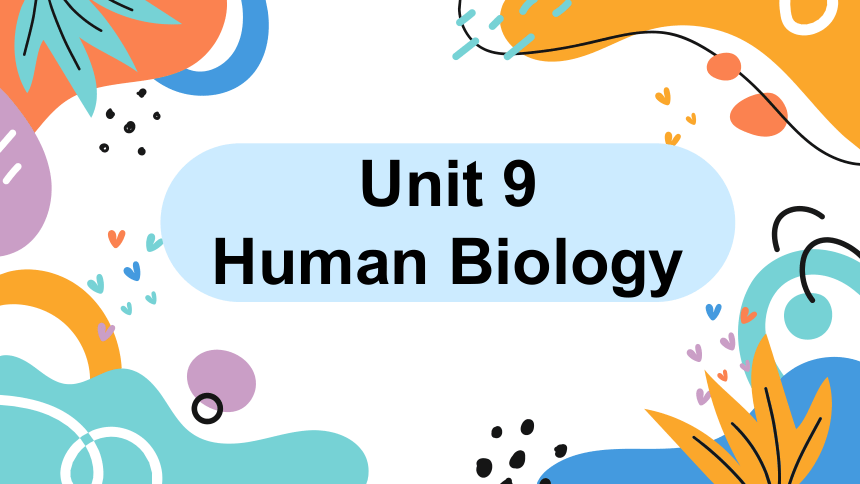 | |
| 格式 | pptx | ||
| 文件大小 | 2.2MB | ||
| 资源类型 | 教案 | ||
| 版本资源 | 北师大版(2019) | ||
| 科目 | 英语 | ||
| 更新时间 | 2025-04-02 21:51:45 | ||
图片预览

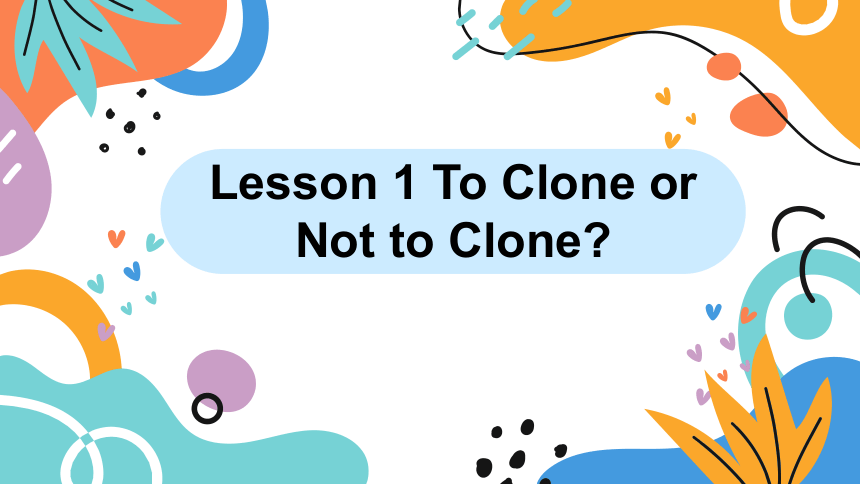
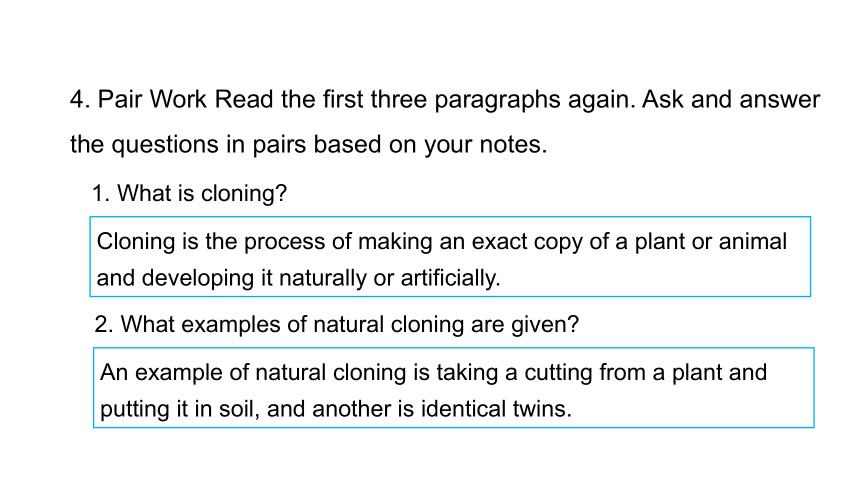
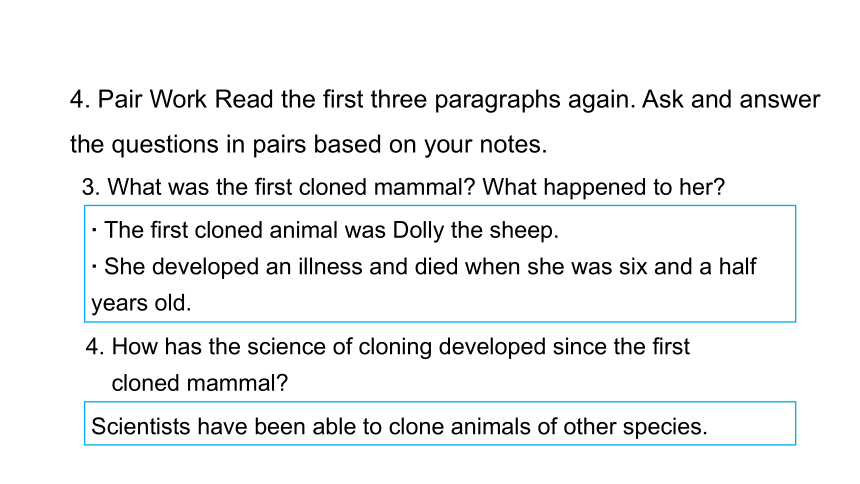
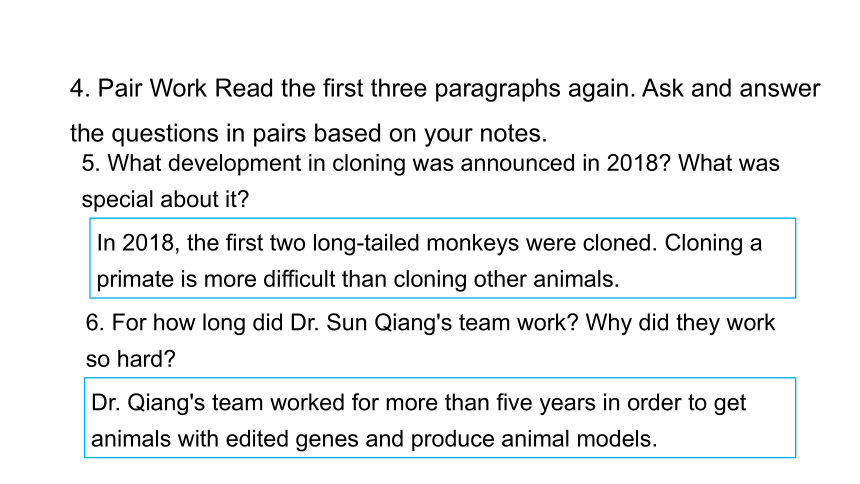
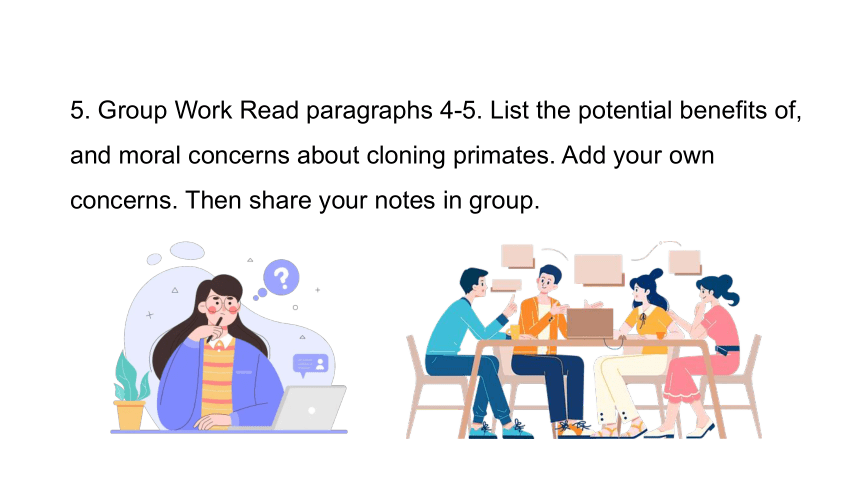
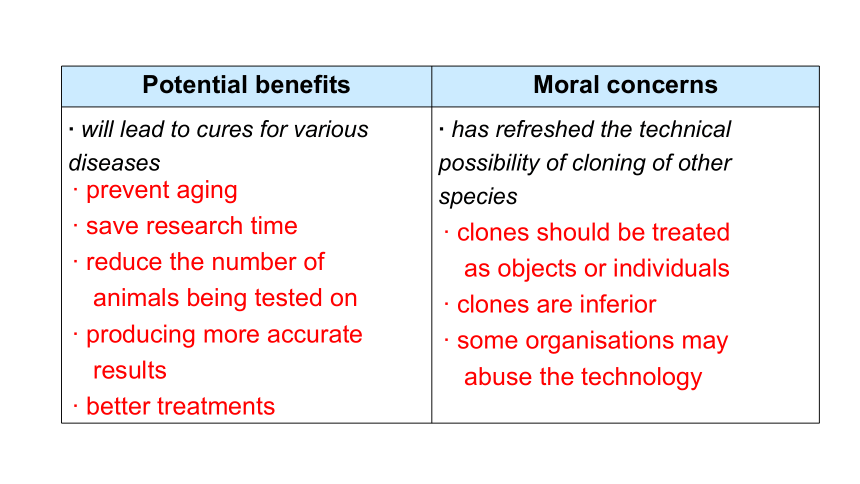
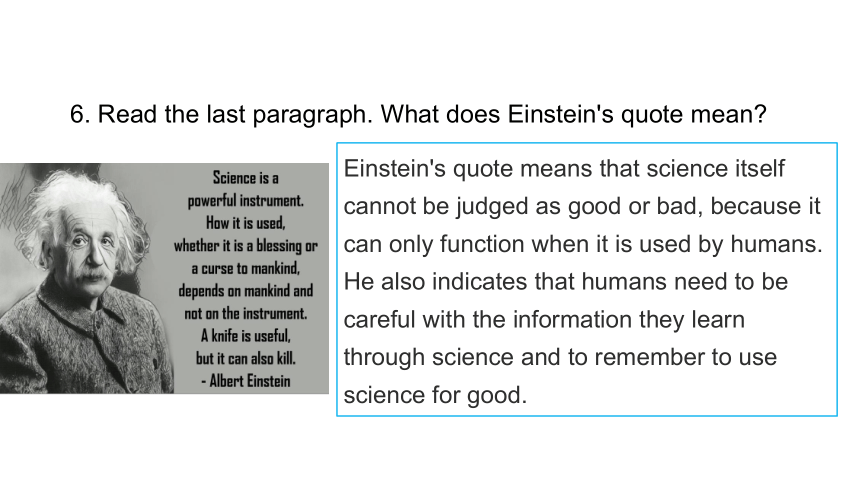
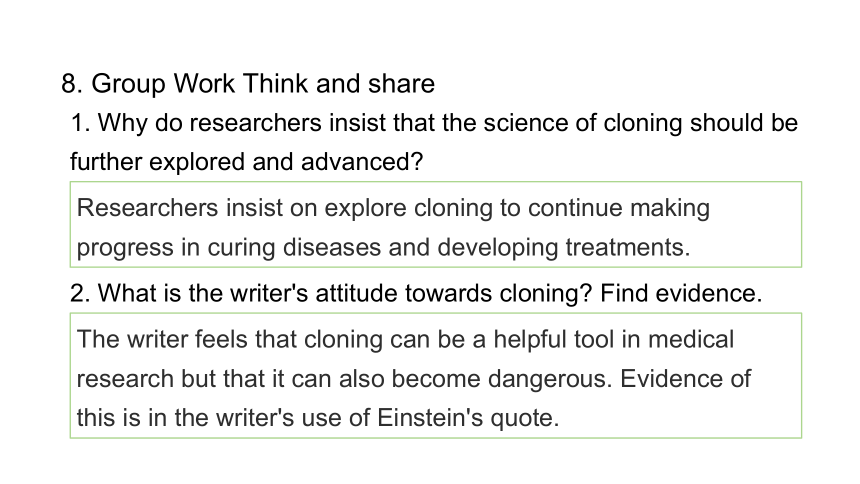
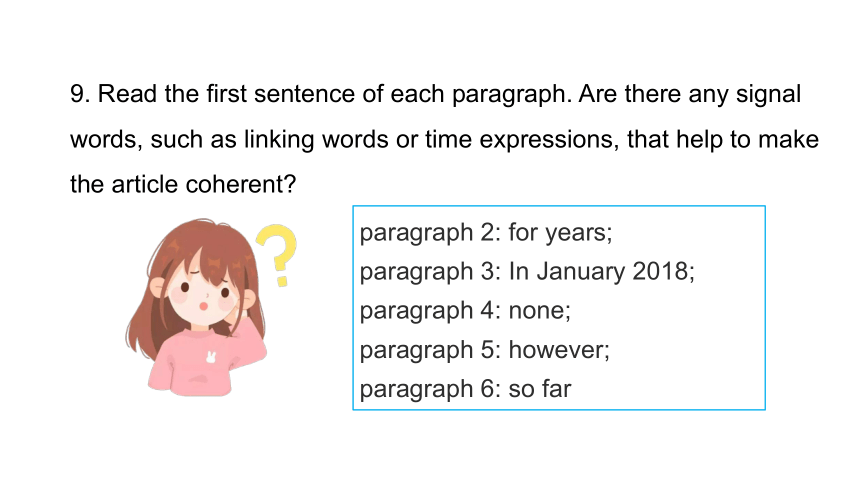
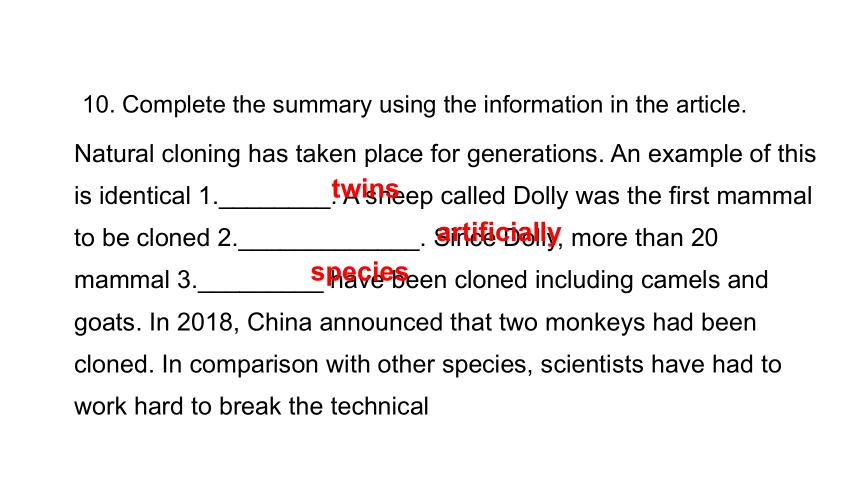
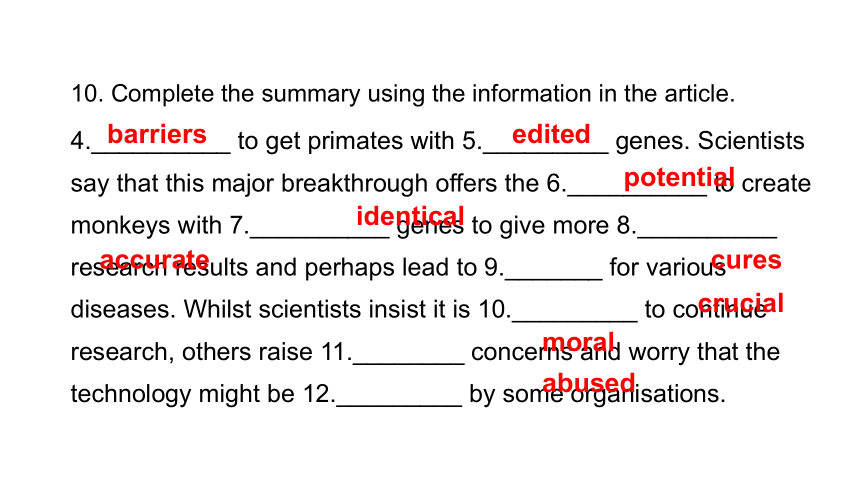
文档简介
(共50张PPT)
Unit 9
Human Biology
Lesson 1 To Clone or Not to Clone
4. Pair Work Read the first three paragraphs again. Ask and answer the questions in pairs based on your notes.
1. What is cloning
Cloning is the process of making an exact copy of a plant or animal and developing it naturally or artificially.
2. What examples of natural cloning are given
An example of natural cloning is taking a cutting from a plant and putting it in soil, and another is identical twins.
4. Pair Work Read the first three paragraphs again. Ask and answer the questions in pairs based on your notes.
3. What was the first cloned mammal What happened to her
The first cloned animal was Dolly the sheep.
She developed an illness and died when she was six and a half years old.
4. How has the science of cloning developed since the first
cloned mammal
Scientists have been able to clone animals of other species.
4. Pair Work Read the first three paragraphs again. Ask and answer the questions in pairs based on your notes.
5. What development in cloning was announced in 2018 What was special about it
In 2018, the first two long-tailed monkeys were cloned. Cloning a primate is more difficult than cloning other animals.
6. For how long did Dr. Sun Qiang's team work Why did they work so hard
Dr. Qiang's team worked for more than five years in order to get animals with edited genes and produce animal models.
5. Group Work Read paragraphs 4-5. List the potential benefits of, and moral concerns about cloning primates. Add your own concerns. Then share your notes in group.
Potential benefits Moral concerns
will lead to cures for various diseases has refreshed the technical possibility of cloning of other species
prevent aging
save research time
reduce the number of
animals being tested on
producing more accurate
results
better treatments
clones should be treated
as objects or individuals
clones are inferior
some organisations may
abuse the technology
6. Read the last paragraph. What does Einstein's quote mean
Einstein's quote means that science itself cannot be judged as good or bad, because it can only function when it is used by humans. He also indicates that humans need to be careful with the information they learn through science and to remember to use science for good.
1. Why do researchers insist that the science of cloning should be further explored and advanced
8. Group Work Think and share
Researchers insist on explore cloning to continue making progress in curing diseases and developing treatments.
2. What is the writer's attitude towards cloning Find evidence.
The writer feels that cloning can be a helpful tool in medical research but that it can also become dangerous. Evidence of this is in the writer's use of Einstein's quote.
9. Read the first sentence of each paragraph. Are there any signal words, such as linking words or time expressions, that help to make the article coherent
paragraph 2: for years;
paragraph 3: In January 2018;
paragraph 4: none;
paragraph 5: however;
paragraph 6: so far
plete the summary using the information in the article.
Natural cloning has taken place for generations. An example of this is identical 1.________. A sheep called Dolly was the first mammal to be cloned 2._____________. Since Dolly, more than 20 mammal 3._________ have been cloned including camels and goats. In 2018, China announced that two monkeys had been cloned. In comparison with other species, scientists have had to work hard to break the technical
twins
artificially
species
plete the summary using the information in the article.
4.__________ to get primates with 5._________ genes. Scientists say that this major breakthrough offers the 6.__________ to create monkeys with 7.__________ genes to give more 8.__________ research results and perhaps lead to 9._______ for various diseases. Whilst scientists insist it is 10._________ to continue research, others raise 11.________ concerns and worry that the technology might be 12._________ by some organisations.
barriers
edited
potential
identical
accurate
cures
crucial
moral
abused
11. Identify the tense of the sentences and write the number in the correct columns.
1. Natural cloning has been going on for generations.
2. Gardeners have been using a form of cloning when they take a cutting from a plant ...
3. For years, there had been attempts to clone animals.
4. Cloning primates has proved to be "much harder" than cloning other species.
5. Dr. Sun Qiang said they had been wholly devoted to the research ...
6. Dr. Sun Qiang said they had been taking care of more than 1,000 monkeys 24 hours a day, 7 days a week ...
Identify the tense of the sentences and write the number in the correct columns.
Present perfect Present perfect continuous Past perfect Past perfect
continuous
4
1, 2
3, 5
6
have / has done
have / has been doing
had done
had been doing
12. Complete the passage with the proper form of the words in brackets.
On Thursday, the Institute of Neuroscience announced it 1. _____________ (clone) two monkeys using non-reproductive cells. It is reported that researchers all around the world 2. __________________________ (conduct) tests on animals, such as mice and dogs, for many years but couldn’t find a way to clone monkeys. The news of the successful cloning 3.
had cloned
have been conducting
12. Complete the passage with the proper form of the words in brackets.
_________________ (attract) attention from around the world. However, cloning primates 4. _____________________ (also raise) ethical concerns. For example, some people 5. ___________________________ (discuss) issues concerning how clones will be treated in society.
has attracted
have also raised
have been discussing
Lesson 2 Brain Power
1. Pair Work Match the words from the box with their definitions.
atom nerve billion cell organ
( ) 1. one thousand million
( ) 2. a part of the body that has a particular purpose,
e.g. the heart
( ) 3. the smallest piece of something that can exist alone
( ) 4. a tiny part of the body that helps carry messages
to and from the brain
( ) 5. a unit of living matter
billion
organ
atom
nerve
cell
2. Before listening to a lecture about the brain, read the statements and write T (true) or F (false).
( ) 1. The brain consists of only white matter.
( ) 2. The brain weighs just over a kilo.
( ) 3. The brain contains about one billion cells.
( ) 4. The brain uses 10% of the body’s energy.
( ) 5. The brain sends messages in the same way as a
computer works.
( ) 6. There are more possible connections in your brain
than there are atoms in the universe.
F
T
F
F
T
T
3. Listen to the lecture and check your answers to Activity and correct the false ones.
1. The brain consists of grey and white matter.
3. The brain contains over one hundred billion cells.
4. The brain uses 20% of the body's energy.
4. Listen again. Complete the information you hear about the brain. Then tell your partner what you have learnt about the brain.
What matter does it consist of Grey and white matter
How much does it weigh
How much body’s energy does it use
How many cells does it contain
just over a kilo
20%
over one hundred billion cells
4. Listen again. Complete the information you hear about the brain. Then tell your partner what you have learnt about the brain.
How are messages sent The brain cells make up _________________, which are connected by ____________________. The brain sends messages using ______________________.
nerve cells
electrical impulses
electrical impulses
4. Listen again. Complete the information you hear about the brain. Then tell your partner what you have learnt about the brain.
What have we learnt about the brain in the last ten years There are different areas in the brain, which are ____________________________________. We now know which parts of the brain ________________ different parts of our ___________________ from them. The brain also has different areas for different kinds of __________. You have one area for your _________________ and another area for ____________ _____________________________________________.
responsible for different functions
are related to
body and feelings
thinking
first language
a foreign language that you learn when you are older
5. Complete the summary with the words from the lecture.
The brain consists of 1. _____________________ matter. It weighs 2. _____________________. It uses 3. ______________ of the body’s energy. It contains over 4. ____________________________ which make up nerve cells. These nerve cells are connected by electrical impulses. There are more possible connections in one brain than
grey and white
just over a kilo
20%
one hundred billion cells
5. Complete the summary with the words from the lecture.
there are 5. _________________________. Scientists have mapped different areas of the brain that are responsible for 6. _______________________. There are also different areas for different types of thinking, such as learning your own language and learning a 7. ______________ language.
atoms in the universe
different functions
foreign
6. Listen to a student phone-in programme and complete the table.
What problem do they have What can they do
Anna:_________________________________________________ ___________________________ ___________________________
______________________________________________________
Memory isn’t as good as it used to be, so do brain exercises really work
challenge their brain with learning new things they are not good at
6. Listen to a student phone-in programme and complete the table.
What problem do they have What can they do
John:_________________________________________________ ________________________________________________________ ___________ on junk food, _____________________ of Omega-3 fats
Exams is coming up, so he wonders if there are certain foods that are good for the brain.
cut down
increase the intake
4. Listen to a student phone-in programme and complete the table.
What problem do they have What can they do
Bella:_________________________________________________ ________________________________________________________ ___________________________
______________________________________________________
Is there any particular kind of exercise that can improve the health of her brain
do exercise that is good for the heart, such as walking and running
7. Listen and plete the Talk Builder.
Asking for and Giving Advice
Asking for Advice
1. _________________ try them
2. ______________________, Professor Kim
3. So what kind of activities _____________________
4. Is there any particular kind of exercise… _____________________
Should I
What’s your advice
What should I do
do you suggest
7. Listen and plete the Talk Builder.
Asking for and Giving Advice
Giving Advice
1. _________________________ try learning a new language …
2. _________________________ is to cut down on junk food.
3. ______________________________ increase your intake of …
4. _________________________ do exercise that is good for your heart.
You could
One thing you can do
It might also be a good idea to
I advise you to
Lesson 3
Epidemics Explained
2. Read the passage. Find out what an epidemic is and how a disease can be classified as an epidemic, Then circle all the epidemics mentioned in the passage.
bird flu,
the 1918 Spanish Flu,
the Black Death,
SARS,
the Ebola Virus Disease (EVD)
3. Pair Work Read the passage again. Complete the table about the epidemics mentioned. Then choose one disease to talk about with a partner.
Name Period Places Death toll
Bird Flu ×
Epidemics in the Roman Empire
The Black Death ×
since 1997
more than a hundred lives
500—550 CE
Rome
half the population
1330s
Asia and Europe
Name Period Places Death toll
The Spanish Flu ×
SARS ×
EVD
1918—the end of World War I
50 million people
2002—2003
China, Canada, Vietnam and Singapore
2013—2016
West Africa
more than 11310 death
3. Pair Work Read the passage again. Complete the table about the epidemics mentioned. Then choose one disease to talk about with a partner.
4. Tick (√) the aspects of information that are mentioned in the passage.
□ when epidemics started
□ examples of epidemics
□ treatments
□ baseline number of deaths of epidemics
√
□ definition
□ when it ended
□ possible causes of epidemics
□ possible solutions
√
√
√
√
√
1. What are the main features of an epidemic Give at least two examples to illustrate your points.
5. Group Work Discuss the questions.
The main features of an epidemic: (1) it is an infectious disease (2) it spreads rapidly to a large number of people within a short period of time (3) a certain number of deaths have occurred from the disease. The common cold is not an epidemic because while it affects many people, it does not cause deaths. SARS affected many people and caused many deaths, so it is considered an epidemic.
5. Group Work Discuss the questions.
2. What should different countries do to prevent outbreaks of epidemics in the future Why
Countries will need to work together to do this because teamwork among nations across the globe can save lives. This is a good example of building a community with shared future for mankind.
5. Group Work Discuss the questions.
3. What does the title mean to you What does the writer want to convey in the passage
The title means that the passage will explain questions about epidemics. The author wants to convey the information that we are always on our way to find an explanation to epidemics so as to find cure. It also implies that epidemics occurred naturally and inevitably. We can only explain it, and cannot prevent it or stop it completely now.
5. Group Work Discuss the questions.
4. What do you think the passage is written for
This is a popular science article. It is more likely to be written for people who are interested in this topic or who have a lot of questions or misunderstanding of epidemics.
6. Complete these sentences in your own words.
1. Epidemics can be caused by a virus being carried into an area, or changes in the way people live.
2. Diseases can only be officially classified as epidemics when a baseline number of people have died from the disease.
3. The Spanish Flu spread worldwide because soldiers and other people were moving and travelling around the world after World War I.
6. Complete these sentences in your own words.
4. Since the end of the SARS epidemic, scientists have been doing experiments on treatments to prevent further outbreaks.
5. Countries need to work together to conduct thorough and systematic research because teamwork among nations across the globe can save lives.
7. Choose prepositions or adverbs in the box to make phrasal verbs with the three verbs in the Word Builder.
Phrasal Verbs (2)
at into over up with through under up away
(The prepositions and adverbs may be used more than once.)
go_____________________________________________________.
get ____________________________________________________.
come __________________________________________________.
at, over, through, away
at, into, over, through, up, away
at, into, over, up with, up, away
7. Then use the phrasal verbs to complete the following sentences.
1. The medical expert asked a few questions to try to ___________ the truth.
2. Books on epidemics ___________ the medicine section of the store.
3. During this course, we’ll ___________the main causes of bird flu.
4. It took him a week to ___________ the flu.
come at
go under
go over
get over
7. Then use the phrasal verbs to complete the following sentences.
5. Has your headache ___________ yet
6. The price of this drug has ___________ twenty cents since August.
7. Are you willing to stand by him and help him _____________ this difficult time
8. Jordan has __________________some creative ideas for helping the sick.
got over
gone up
go through
come up with
Writing Workshop
2. Read the text “Epidemics Explained” in this unit. How many parts can it be divided into Which paragraphs may be included into each part Complete the first column of the table. Then match the key information below for each part.
Some epidemics were connected
Definition
Cooperation needed to fight against epidemics
Epidemics in the 21st century
The Text “Epidemics Explained” Parts Corresponding paragraphs Key information
1
2
3
4
1-2
Definition
3-6
Some epidemics were connected
7-8
Epidemics in the 21st century
9
Cooperation needed to fight against epidemics
5. Read the paragraph below. What’s the main idea of this paragraph Underline the key words.
Cloning is the process of making an exact copy of a plant or animal and developing it either naturally or artificially. Natural cloning has been going on for generations. For example, gardeners have been using a form of cloning when they take a cutting from a plant and place it in a suitable medium, such as soil. Another example of natural cloning is identical twins, who are produced from the same egg.
5. Read the paragraph below. Summarise the paragraph in one sentence.
Cloning is the process of making an exact copy of a plant or animal and developing it either naturally or artificially. Natural cloning has been going on for generations. For example, gardeners have been using a form of cloning when they take a cutting from a plant and place it in a suitable medium, such as soil. Another example of natural cloning is identical twins, who are produced from the same egg.
Summary: Cloning means to make exact copy of a plant or animal and natural cloning has been going on for generations.
Thank you
Unit 9
Human Biology
Lesson 1 To Clone or Not to Clone
4. Pair Work Read the first three paragraphs again. Ask and answer the questions in pairs based on your notes.
1. What is cloning
Cloning is the process of making an exact copy of a plant or animal and developing it naturally or artificially.
2. What examples of natural cloning are given
An example of natural cloning is taking a cutting from a plant and putting it in soil, and another is identical twins.
4. Pair Work Read the first three paragraphs again. Ask and answer the questions in pairs based on your notes.
3. What was the first cloned mammal What happened to her
The first cloned animal was Dolly the sheep.
She developed an illness and died when she was six and a half years old.
4. How has the science of cloning developed since the first
cloned mammal
Scientists have been able to clone animals of other species.
4. Pair Work Read the first three paragraphs again. Ask and answer the questions in pairs based on your notes.
5. What development in cloning was announced in 2018 What was special about it
In 2018, the first two long-tailed monkeys were cloned. Cloning a primate is more difficult than cloning other animals.
6. For how long did Dr. Sun Qiang's team work Why did they work so hard
Dr. Qiang's team worked for more than five years in order to get animals with edited genes and produce animal models.
5. Group Work Read paragraphs 4-5. List the potential benefits of, and moral concerns about cloning primates. Add your own concerns. Then share your notes in group.
Potential benefits Moral concerns
will lead to cures for various diseases has refreshed the technical possibility of cloning of other species
prevent aging
save research time
reduce the number of
animals being tested on
producing more accurate
results
better treatments
clones should be treated
as objects or individuals
clones are inferior
some organisations may
abuse the technology
6. Read the last paragraph. What does Einstein's quote mean
Einstein's quote means that science itself cannot be judged as good or bad, because it can only function when it is used by humans. He also indicates that humans need to be careful with the information they learn through science and to remember to use science for good.
1. Why do researchers insist that the science of cloning should be further explored and advanced
8. Group Work Think and share
Researchers insist on explore cloning to continue making progress in curing diseases and developing treatments.
2. What is the writer's attitude towards cloning Find evidence.
The writer feels that cloning can be a helpful tool in medical research but that it can also become dangerous. Evidence of this is in the writer's use of Einstein's quote.
9. Read the first sentence of each paragraph. Are there any signal words, such as linking words or time expressions, that help to make the article coherent
paragraph 2: for years;
paragraph 3: In January 2018;
paragraph 4: none;
paragraph 5: however;
paragraph 6: so far
plete the summary using the information in the article.
Natural cloning has taken place for generations. An example of this is identical 1.________. A sheep called Dolly was the first mammal to be cloned 2._____________. Since Dolly, more than 20 mammal 3._________ have been cloned including camels and goats. In 2018, China announced that two monkeys had been cloned. In comparison with other species, scientists have had to work hard to break the technical
twins
artificially
species
plete the summary using the information in the article.
4.__________ to get primates with 5._________ genes. Scientists say that this major breakthrough offers the 6.__________ to create monkeys with 7.__________ genes to give more 8.__________ research results and perhaps lead to 9._______ for various diseases. Whilst scientists insist it is 10._________ to continue research, others raise 11.________ concerns and worry that the technology might be 12._________ by some organisations.
barriers
edited
potential
identical
accurate
cures
crucial
moral
abused
11. Identify the tense of the sentences and write the number in the correct columns.
1. Natural cloning has been going on for generations.
2. Gardeners have been using a form of cloning when they take a cutting from a plant ...
3. For years, there had been attempts to clone animals.
4. Cloning primates has proved to be "much harder" than cloning other species.
5. Dr. Sun Qiang said they had been wholly devoted to the research ...
6. Dr. Sun Qiang said they had been taking care of more than 1,000 monkeys 24 hours a day, 7 days a week ...
Identify the tense of the sentences and write the number in the correct columns.
Present perfect Present perfect continuous Past perfect Past perfect
continuous
4
1, 2
3, 5
6
have / has done
have / has been doing
had done
had been doing
12. Complete the passage with the proper form of the words in brackets.
On Thursday, the Institute of Neuroscience announced it 1. _____________ (clone) two monkeys using non-reproductive cells. It is reported that researchers all around the world 2. __________________________ (conduct) tests on animals, such as mice and dogs, for many years but couldn’t find a way to clone monkeys. The news of the successful cloning 3.
had cloned
have been conducting
12. Complete the passage with the proper form of the words in brackets.
_________________ (attract) attention from around the world. However, cloning primates 4. _____________________ (also raise) ethical concerns. For example, some people 5. ___________________________ (discuss) issues concerning how clones will be treated in society.
has attracted
have also raised
have been discussing
Lesson 2 Brain Power
1. Pair Work Match the words from the box with their definitions.
atom nerve billion cell organ
( ) 1. one thousand million
( ) 2. a part of the body that has a particular purpose,
e.g. the heart
( ) 3. the smallest piece of something that can exist alone
( ) 4. a tiny part of the body that helps carry messages
to and from the brain
( ) 5. a unit of living matter
billion
organ
atom
nerve
cell
2. Before listening to a lecture about the brain, read the statements and write T (true) or F (false).
( ) 1. The brain consists of only white matter.
( ) 2. The brain weighs just over a kilo.
( ) 3. The brain contains about one billion cells.
( ) 4. The brain uses 10% of the body’s energy.
( ) 5. The brain sends messages in the same way as a
computer works.
( ) 6. There are more possible connections in your brain
than there are atoms in the universe.
F
T
F
F
T
T
3. Listen to the lecture and check your answers to Activity and correct the false ones.
1. The brain consists of grey and white matter.
3. The brain contains over one hundred billion cells.
4. The brain uses 20% of the body's energy.
4. Listen again. Complete the information you hear about the brain. Then tell your partner what you have learnt about the brain.
What matter does it consist of Grey and white matter
How much does it weigh
How much body’s energy does it use
How many cells does it contain
just over a kilo
20%
over one hundred billion cells
4. Listen again. Complete the information you hear about the brain. Then tell your partner what you have learnt about the brain.
How are messages sent The brain cells make up _________________, which are connected by ____________________. The brain sends messages using ______________________.
nerve cells
electrical impulses
electrical impulses
4. Listen again. Complete the information you hear about the brain. Then tell your partner what you have learnt about the brain.
What have we learnt about the brain in the last ten years There are different areas in the brain, which are ____________________________________. We now know which parts of the brain ________________ different parts of our ___________________ from them. The brain also has different areas for different kinds of __________. You have one area for your _________________ and another area for ____________ _____________________________________________.
responsible for different functions
are related to
body and feelings
thinking
first language
a foreign language that you learn when you are older
5. Complete the summary with the words from the lecture.
The brain consists of 1. _____________________ matter. It weighs 2. _____________________. It uses 3. ______________ of the body’s energy. It contains over 4. ____________________________ which make up nerve cells. These nerve cells are connected by electrical impulses. There are more possible connections in one brain than
grey and white
just over a kilo
20%
one hundred billion cells
5. Complete the summary with the words from the lecture.
there are 5. _________________________. Scientists have mapped different areas of the brain that are responsible for 6. _______________________. There are also different areas for different types of thinking, such as learning your own language and learning a 7. ______________ language.
atoms in the universe
different functions
foreign
6. Listen to a student phone-in programme and complete the table.
What problem do they have What can they do
Anna:_________________________________________________ ___________________________ ___________________________
______________________________________________________
Memory isn’t as good as it used to be, so do brain exercises really work
challenge their brain with learning new things they are not good at
6. Listen to a student phone-in programme and complete the table.
What problem do they have What can they do
John:_________________________________________________ ________________________________________________________ ___________ on junk food, _____________________ of Omega-3 fats
Exams is coming up, so he wonders if there are certain foods that are good for the brain.
cut down
increase the intake
4. Listen to a student phone-in programme and complete the table.
What problem do they have What can they do
Bella:_________________________________________________ ________________________________________________________ ___________________________
______________________________________________________
Is there any particular kind of exercise that can improve the health of her brain
do exercise that is good for the heart, such as walking and running
7. Listen and plete the Talk Builder.
Asking for and Giving Advice
Asking for Advice
1. _________________ try them
2. ______________________, Professor Kim
3. So what kind of activities _____________________
4. Is there any particular kind of exercise… _____________________
Should I
What’s your advice
What should I do
do you suggest
7. Listen and plete the Talk Builder.
Asking for and Giving Advice
Giving Advice
1. _________________________ try learning a new language …
2. _________________________ is to cut down on junk food.
3. ______________________________ increase your intake of …
4. _________________________ do exercise that is good for your heart.
You could
One thing you can do
It might also be a good idea to
I advise you to
Lesson 3
Epidemics Explained
2. Read the passage. Find out what an epidemic is and how a disease can be classified as an epidemic, Then circle all the epidemics mentioned in the passage.
bird flu,
the 1918 Spanish Flu,
the Black Death,
SARS,
the Ebola Virus Disease (EVD)
3. Pair Work Read the passage again. Complete the table about the epidemics mentioned. Then choose one disease to talk about with a partner.
Name Period Places Death toll
Bird Flu ×
Epidemics in the Roman Empire
The Black Death ×
since 1997
more than a hundred lives
500—550 CE
Rome
half the population
1330s
Asia and Europe
Name Period Places Death toll
The Spanish Flu ×
SARS ×
EVD
1918—the end of World War I
50 million people
2002—2003
China, Canada, Vietnam and Singapore
2013—2016
West Africa
more than 11310 death
3. Pair Work Read the passage again. Complete the table about the epidemics mentioned. Then choose one disease to talk about with a partner.
4. Tick (√) the aspects of information that are mentioned in the passage.
□ when epidemics started
□ examples of epidemics
□ treatments
□ baseline number of deaths of epidemics
√
□ definition
□ when it ended
□ possible causes of epidemics
□ possible solutions
√
√
√
√
√
1. What are the main features of an epidemic Give at least two examples to illustrate your points.
5. Group Work Discuss the questions.
The main features of an epidemic: (1) it is an infectious disease (2) it spreads rapidly to a large number of people within a short period of time (3) a certain number of deaths have occurred from the disease. The common cold is not an epidemic because while it affects many people, it does not cause deaths. SARS affected many people and caused many deaths, so it is considered an epidemic.
5. Group Work Discuss the questions.
2. What should different countries do to prevent outbreaks of epidemics in the future Why
Countries will need to work together to do this because teamwork among nations across the globe can save lives. This is a good example of building a community with shared future for mankind.
5. Group Work Discuss the questions.
3. What does the title mean to you What does the writer want to convey in the passage
The title means that the passage will explain questions about epidemics. The author wants to convey the information that we are always on our way to find an explanation to epidemics so as to find cure. It also implies that epidemics occurred naturally and inevitably. We can only explain it, and cannot prevent it or stop it completely now.
5. Group Work Discuss the questions.
4. What do you think the passage is written for
This is a popular science article. It is more likely to be written for people who are interested in this topic or who have a lot of questions or misunderstanding of epidemics.
6. Complete these sentences in your own words.
1. Epidemics can be caused by a virus being carried into an area, or changes in the way people live.
2. Diseases can only be officially classified as epidemics when a baseline number of people have died from the disease.
3. The Spanish Flu spread worldwide because soldiers and other people were moving and travelling around the world after World War I.
6. Complete these sentences in your own words.
4. Since the end of the SARS epidemic, scientists have been doing experiments on treatments to prevent further outbreaks.
5. Countries need to work together to conduct thorough and systematic research because teamwork among nations across the globe can save lives.
7. Choose prepositions or adverbs in the box to make phrasal verbs with the three verbs in the Word Builder.
Phrasal Verbs (2)
at into over up with through under up away
(The prepositions and adverbs may be used more than once.)
go_____________________________________________________.
get ____________________________________________________.
come __________________________________________________.
at, over, through, away
at, into, over, through, up, away
at, into, over, up with, up, away
7. Then use the phrasal verbs to complete the following sentences.
1. The medical expert asked a few questions to try to ___________ the truth.
2. Books on epidemics ___________ the medicine section of the store.
3. During this course, we’ll ___________the main causes of bird flu.
4. It took him a week to ___________ the flu.
come at
go under
go over
get over
7. Then use the phrasal verbs to complete the following sentences.
5. Has your headache ___________ yet
6. The price of this drug has ___________ twenty cents since August.
7. Are you willing to stand by him and help him _____________ this difficult time
8. Jordan has __________________some creative ideas for helping the sick.
got over
gone up
go through
come up with
Writing Workshop
2. Read the text “Epidemics Explained” in this unit. How many parts can it be divided into Which paragraphs may be included into each part Complete the first column of the table. Then match the key information below for each part.
Some epidemics were connected
Definition
Cooperation needed to fight against epidemics
Epidemics in the 21st century
The Text “Epidemics Explained” Parts Corresponding paragraphs Key information
1
2
3
4
1-2
Definition
3-6
Some epidemics were connected
7-8
Epidemics in the 21st century
9
Cooperation needed to fight against epidemics
5. Read the paragraph below. What’s the main idea of this paragraph Underline the key words.
Cloning is the process of making an exact copy of a plant or animal and developing it either naturally or artificially. Natural cloning has been going on for generations. For example, gardeners have been using a form of cloning when they take a cutting from a plant and place it in a suitable medium, such as soil. Another example of natural cloning is identical twins, who are produced from the same egg.
5. Read the paragraph below. Summarise the paragraph in one sentence.
Cloning is the process of making an exact copy of a plant or animal and developing it either naturally or artificially. Natural cloning has been going on for generations. For example, gardeners have been using a form of cloning when they take a cutting from a plant and place it in a suitable medium, such as soil. Another example of natural cloning is identical twins, who are produced from the same egg.
Summary: Cloning means to make exact copy of a plant or animal and natural cloning has been going on for generations.
Thank you
